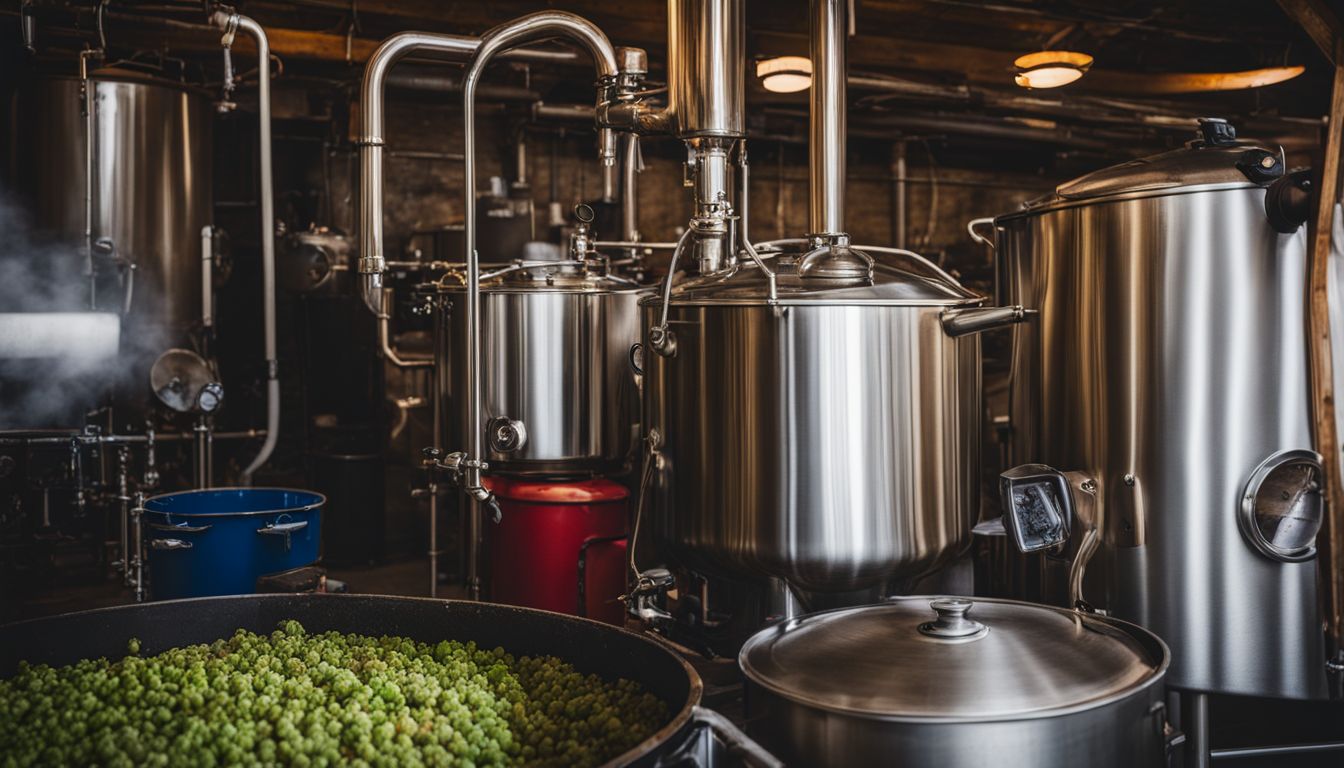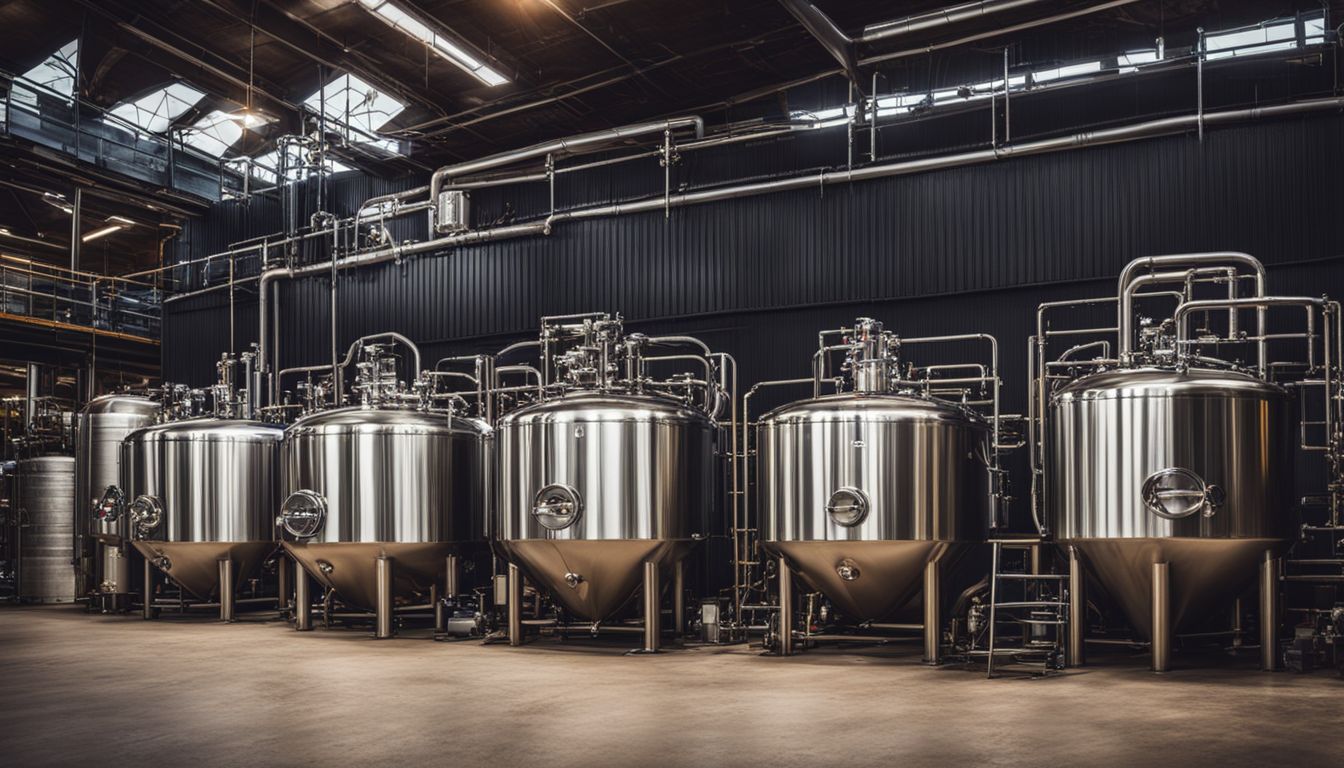Have you ever wondered how your favourite beer is made? The industrial brewing process involves more than just mixing hops, water, and yeast. It’s an art involving eight distinctive steps that need to be painstakingly followed.
This article will guide you through each step of the process – from malting to packaging – unfolding the mystery behind every refreshing sip of beer you enjoy. Ready for a journey where science meets taste?.
Key Takeaways
- The industrial brewing process involves eight distinctive steps, including malt milling, mashing, lautering, wort boiling, clarification, cooling, fermentation, and packaging.
- Each step in the brewing process has a specific purpose to ensure the beer is of high quality and delicious.
- Important steps like mashing and boiling help convert starches into sugars and extract flavors from hops.
- Clarification and cooling remove impurities and settle out unwanted particles to create a clean liquid base for fermentation.
The Stages of Industrial Brewing Processes

The stages of industrial brewing processes include malt milling, mashing, lautering, wort boiling, clarification, and cooling.
Malt Milling
Malt milling breaks down malted barley. This is the first step in making beer. Big machines, or mills, do this job. They crush the malt into small bits called grist. The milled malt is now ready for the next step, mashing! But care is key here: not too fine and not too rough should be the grind.
A good mill makes sure of that. Too much powder can cause trouble later on!
Mashing

Mashing is a crucial step in the brewing process where the milled malt or grist is mixed with hot water in a vessel called a mash tun. This creates an environment that allows enzymes to break down complex starches into simpler sugars.
These sugars will later be fermented by yeast to produce alcohol and carbon dioxide. During mashing, temperature control is important as different temperatures activate specific enzymes that convert starches into different types of sugar.
By carefully controlling the temperature and duration of mashing, brewers can achieve desired flavors and characteristics in their beer. It’s an essential step that sets the stage for creating delicious brews!
Lautering

Lautering is an important step in the brewing process. After mashing, where the malt is mixed with hot water to extract sugars and flavors, lautering involves separating the liquid from the solid grain particles.
This separation process is done using a device called a lauter tun or vessel. The liquid extracted during lautering is known as wort, which will later be boiled and fermented to make beer.
Lautering requires careful control of temperature, flow rate, and filtering techniques to ensure that only clear wort passes through while leaving behind any unwanted husks or solids.
Wort Boiling

During the brewing process, one important step is wort boiling. After the malt has been milled and mashed, the liquid called wort is separated from solid particles. The next step is to boil the wort.
Boiling serves many purposes in beer production – it helps sanitize the wort by killing off any unwanted microorganisms, extracts flavors from hops that give beer its bitterness and aroma, and promotes chemical reactions that enhance beer quality.
The boiling process can last for about an hour or more depending on the recipe. It’s crucial to control temperature and time to achieve desired results. Once boiled, the wort goes through clarification and cooling before fermentation begins.
Clarification

During the brewing process, clarification is a crucial step in ensuring that the beer is clear and free from any unwanted particles. This step involves the use of filtration or centrifugation to remove solids and haze from the beer.
Clarification helps improve the overall appearance of the beer by making it visually appealing and bright. It also plays a role in enhancing its stability and extending its shelf life.
By removing unwanted elements, clarification ensures that every sip you take is enjoyable and satisfying, with no unpleasant surprises. So next time you raise your glass to enjoy a cold one, remember that clarification is an important part of creating that perfect pint.
Cooling

In the brewing process, after the wort is boiled, it needs to be cooled down. This is an important step because if the wort stays hot for too long, it can attract unwanted microorganisms and spoil the beer.
Cooling also helps to clarify the beer by causing proteins and other solids to settle out.
One way to cool down the wort is through a heat exchanger system. The hot wort passes through one side of a metal plate, while cold water flows on the other side. As they pass each other, heat from the wort is transferred to the cold water, rapidly bringing down its temperature.
Another method used in large-scale breweries is called whirlpool chilling. In this process, after boiling, the hot wort is stirred vigorously creating a whirlpool effect. This helps in settling out unwanted particles like hop residues or break material that might have been left behind during boiling.
Fermentation

Fermentation is an important step in the brewing process. It happens after the wort has been boiled and cooled down. During fermentation, yeast is added to the wort, which contains sugars from malted barley.
The yeast consumes these sugars and produces alcohol and carbon dioxide as byproducts. This is what gives beer its alcoholic content and fizzy bubbles. Fermentation can take anywhere from a few days to several weeks, depending on the type of beer being made.
After fermentation, the beer is conditioned and then packaged for distribution to enjoy!
https://www.youtube.com/watch?v=i1mp1oMZKJQ
Conditioning

Conditioning is a crucial step in the process of brewing beer. After fermentation, the beer undergoes a period of conditioning to enhance its flavor and carbonation. During this stage, the beer is transferred to conditioning tanks where it is kept at a controlled temperature for several weeks or even months.
This allows any remaining yeast, sediment, and impurities to settle at the bottom of the tank.
The conditioning process also helps in smoothing out any harsh flavors and creating a well-rounded taste. It allows the flavors of hops and malt to blend together harmoniously, resulting in a balanced and enjoyable drinking experience.
Additionally, carbonation levels are adjusted during conditioning by adding just the right amount of sugar or carbon dioxide.
Once the beer has undergone sufficient conditioning, it is then ready for packaging. This can include bottling or kegging depending on how it will be sold or consumed. The beer is carefully filtered before packaging to ensure clarity and remove any remaining sediment.
Thus, conditioning plays an essential role in producing high-quality beer with desirable flavors and appropriate levels of carbonation.
Packaging

Packaging is the final step in the beer production process. After fermentation and conditioning, it’s time to put the beer into bottles or cans. Packaging helps keep the beer fresh and protected from light and oxygen.
It also makes it easier for you to take your favorite brew home or enjoy it with friends at parties or gatherings. The packaging materials used can vary, but common options include glass bottles, aluminum cans, and kegs.
Before being packaged, the beer goes through a filtration process to remove any sediment or impurities. This ensures that you get a clear and clean drink every time you open a bottle or can of beer.
freshness, protection, light exposure]
Conclusion

In conclusion, understanding the step-by-step guide to industrial brewing processes is essential for producing great-tasting beer. Each stage, from malting to packaging, plays a crucial role in creating high-quality brews.
By following these steps with attention to detail, breweries can ensure that their beers are enjoyed by beer drinkers worldwide. Cheers to the art of brewing!
FAQs
1. What are the main steps involved in industrial brewing processes?
The main steps in industrial brewing processes include malting, mashing, boiling, fermenting, filtering, and packaging.
2. How long does it take to complete the industrial brewing process?
The duration of the industrial brewing process can vary depending on factors such as the type of beer being brewed and the specific brewery’s methods. However, it typically takes several weeks to complete.
3. What is the purpose of filtering in industrial brewing processes?
Filtering is an important step in industrial brewing processes as it helps remove impurities from the beer and provides clarity and stability to the final product.
4. Can I brew beer using these industrial techniques at home?
While some aspects of industrial brewing processes can be replicated at home, such as fermentation and bottling, certain steps require specialized equipment that may not be feasible for homebrewers. It’s best to start with small-scale homebrewing kits before attempting larger-scale techniques used in industrial breweries.
